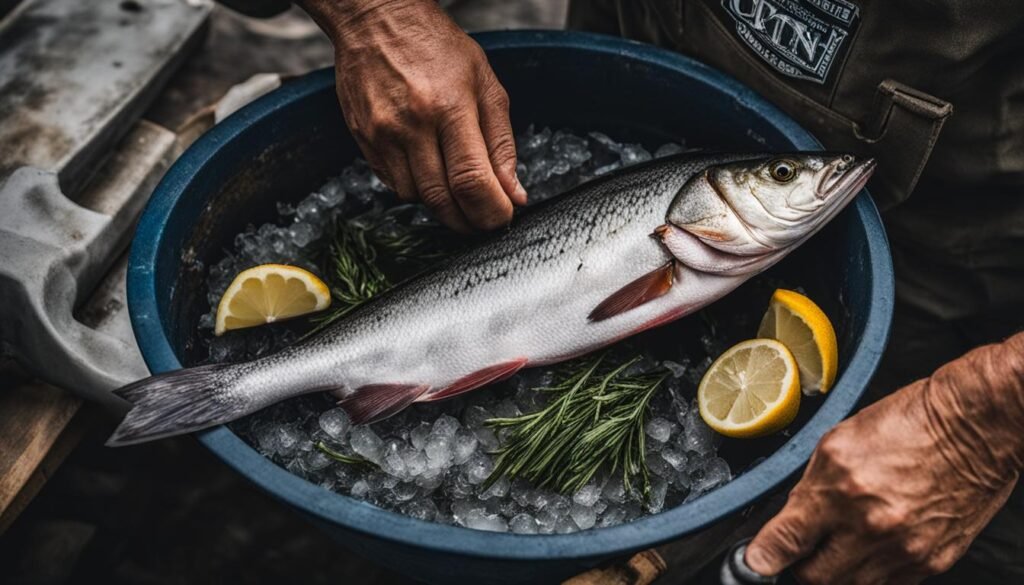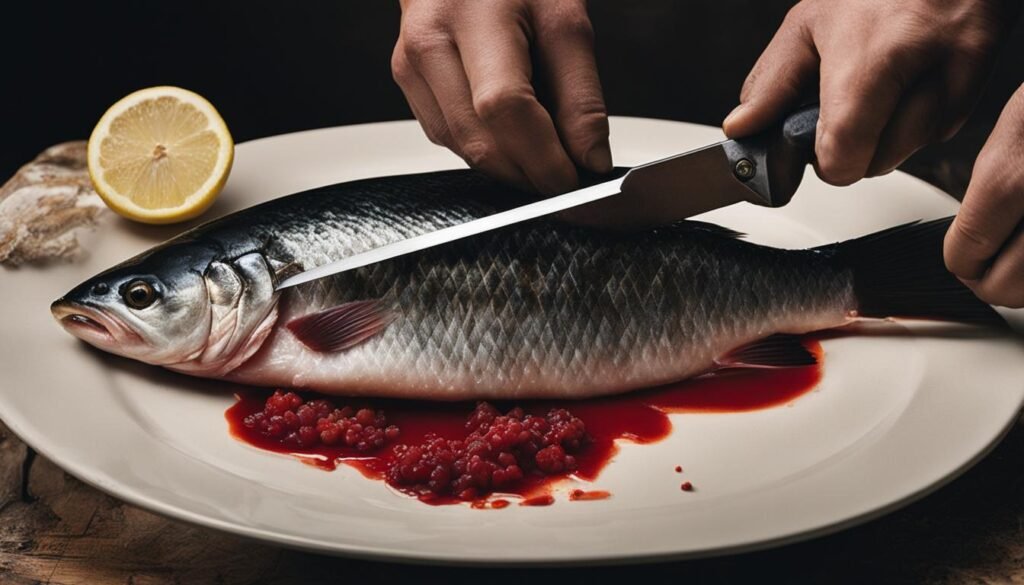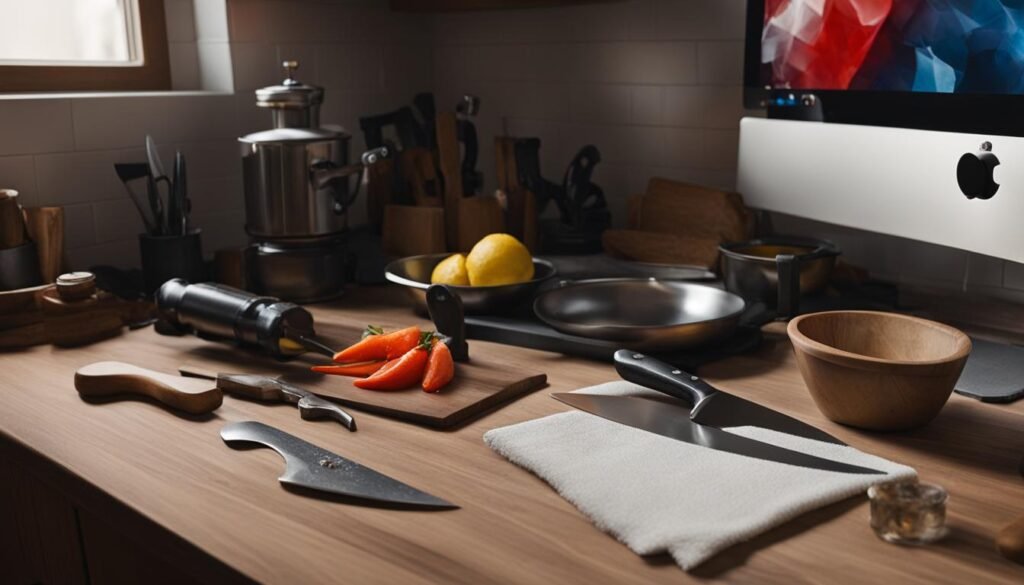Explore Canada's Ultimate Fishing, Hunting, and Wildlife Adventures

Step-by-Step Guide on How to Gut a Fish Safely
Table of Contents
Gutting a fish is an essential skill for anglers and home cooks who want to prepare their catch for cooking. This step-by-step guide will provide you with all the necessary information and techniques to safely and effectively gut a fish.
From subduing the fish to cleaning the abdominal cavity, you’ll learn the proper tools, techniques, and precautions to ensure a successful gutting process.
Whether you’re a beginner or an experienced angler, this guide will help you master the art of gutting fish.
Disclosure: When you purchase a service or a product through our links, we sometimes earn a commission, at no extra cost to you.
Key Takeaways
- Learn the step-by-step process of gutting a fish safely and effectively.
- Understand the importance of cleaning your catch for improved taste, texture, and food safety.
- Discover humane methods of subduing and preparing the fish before gutting.
- Acquire the necessary tools for fish gutting and understand their proper usage.
- Master the techniques for removing fins, scales, and eviscerating the fish.
10 interesting facts about how to gut a fish safely that many people might not be aware of
- Humaneness is Key: One of the first steps in gutting a fish involves humanely dispatching the fish. This is important not just for ethical reasons but also because stress can affect the quality of the meat.
- Location of the Initial Cut: Many are surprised to learn that the initial incision is made at the vent of the fish, near the anal opening. This is crucial for a clean and effective gutting process.
- Ice is Essential: Immediate cooling of the fish post-capture is vital. This preserves the fish’s freshness and flavor and slows down bacterial growth.
- The Importance of Sharp Tools: Sharp knives and tools are essential not just for efficiency but also to prevent unnecessary tearing of the fish’s flesh and organs, which can affect the quality of the meat.
- Removing Fins and Scales: Before gutting, it’s important to remove the fish’s fins and scales. This is often overlooked but is crucial for a cleaner gutting process and better cooking results.
- Rinsing and Cleaning the Abdominal Cavity: Thorough rinsing and cleaning of the abdominal cavity after gutting is necessary to remove any remaining innards, blood, or debris, ensuring the fish is safe and pleasant to eat.
- Environmental Responsibility: Proper disposal of fish waste is important for environmental stewardship. Discarded guts and parts should be handled responsibly to prevent contamination and odor problems.
- The Role of the Kidneys: Removing the kidneys, which are often nestled in the backbone, is a delicate part of the gutting process that’s easily missed but essential for removing any bitter tastes.
- Optional Steps for Customization: Gutting a fish doesn’t end with removing the innards. Steps like filleting or steak cutting are additional skills that can greatly enhance the culinary experience.
- Handling Affects Quality: The way a fish is handled from the moment it’s caught until it’s gutted can significantly impact the quality of the meat. Gentle handling helps maintain the flesh’s integrity and flavor.
Understanding the Importance of Cleaning Your Catch
Cleaning your catch is an important step in preparing fish for consumption. By removing the scales, fins, and internal organs, you not only improve the taste and texture of the fish but also reduce the risk of contamination and ensure food safety. Proper cleaning also helps to preserve the quality and flavor of the fish during storage and cooking.
In this section, we’ll explore the reasons why cleaning your catch is crucial and the benefits it provides.
Initial Steps: Subduing and Preparing the Fish
Before you can gut a fish, it’s important to safely subdue and prepare it. This section will cover two essential steps: humanely dispatching the fish and gathering the necessary tools for preparation. You’ll learn humane methods of rendering the fish unconscious and techniques for ensuring a quick and painless death. We’ll also discuss the tools you’ll need for gutting, including knives, scaling tools, and other essential equipment.
Humanely Dispatching the Fish Before Cleaning
To ensure the humane dispatching of the fish before gutting, it’s important to use methods that minimize stress and pain. One common method is stunning the fish, which involves delivering a quick and accurate blow to the head. This can be done using a blunt object or a specially designed tool. Another method is inserting a sharp object into the fish’s brain, instantly causing unconsciousness and avoiding unnecessary suffering. It’s crucial to utilize these methods to ensure the fish’s well-being and adherence to ethical practices.
Tools You’ll Need to Prepare Your Catch
Having the right tools is essential for preparing fish. Here are some tools you’ll need for a successful gutting process:
- Fillet knife: A sharp and flexible knife specifically designed for precision cutting and filleting.
- Scaling tool: A tool used to remove the scales from the fish’s skin, ensuring a more pleasant dining experience.
- Gutting knife: A strong and durable knife with a curved or hooked blade, ideal for making incisions and removing the fish’s internal organs.
- Cutting board: A sturdy surface for gutting and cutting the fish, ensuring your workspace remains clean and organized.
- Gloves and apron: Protective gear to keep your hands and clothes clean during the gutting process.
By having these tools on hand, you’ll be well-equipped to prepare your catch efficiently and effectively.

How to Gut a Fish
In order to successfully gut a fish, it is important to follow a specific process. This section will provide you with step-by-step instructions on how to properly gut a fish, ensuring a clean and effective outcome.
Disclosure: When you purchase a service or a product through our links, we sometimes earn a commission, at no extra cost to you.
Removing Fins and Scales: A Cleaner Approach
Before proceeding with the gutting process, it is necessary to remove the fins and scales from the fish. This ensures a cleaner and easier gutting experience. To remove the fins, hold the fish firmly and use a sharp knife to carefully cut off the fins at their base. Next, to remove the scales, firmly hold the fish by its tail and scrape the scales away from the head towards the tail using a scaling tool or the back of a knife.
Making the Initial Incision at the Vent
After removing the fins and scales, it is time to make the initial incision at the vent. Hold the fish securely and locate the vent, which is located near the anal opening. Using a sharp knife, make a clean incision from the vent towards the head of the fish. Take caution to avoid cutting too deeply and disturbing the internal organs.
Fly to Your Canadian Fishing Paradise
Book cheap flights to Canada's best fishing spots!
One search, all flights
Find the best deals to your favorite fishing spots
Kiwi.com Guarantee
Travel worry-free with our protection
Trusted by millions
Join anglers booking cheap flights with ease
Disclosure: When you purchase a service or a product through our links, we sometimes earn a commission, at no extra cost to you.
The Proper Technique for Eviscerating the Fish
- With the initial incision made, gently insert your fingers or a gutting tool into the incision and carefully open up the abdominal cavity.
- Using a smooth and controlled motion, pull out the guts and entrails from the fish’s abdominal cavity. Be careful to remove all organs, including the liver, stomach, and intestines.
- Rinse the abdominal cavity with clean water to ensure any remaining debris or blood is removed.
By following these steps, you will be able to successfully gut a fish while maintaining cleanliness and minimizing the risk of contamination. Practice patience and precision, and soon you’ll become proficient in the fish gutting process.
Careful Cleaning: Removing Guts and Kidneys
After successfully gutting the fish, the next step is to ensure thorough cleaning of the abdominal cavity to eliminate any remaining guts and kidneys. Cleaning fish guts and removing fish kidneys is a crucial part of the overall fish cleaning process. This step ensures that no traces of internal organs are left behind.
Proper cleaning techniques are essential to ensure the fish is clean and ready for further processing or cooking. To achieve this, it’s important to follow these precautions and techniques:
- Use a clean, sharp knife to carefully scrape and remove any remaining guts from the abdominal cavity.
- Ensure that the knife is thoroughly cleaned and sanitized before and during the cleaning process.
- Pay close attention to hard-to-reach areas, such as the corners of the abdominal cavity.
- Gently remove the kidneys by carefully separating them from the surrounding tissues using the knife.
- Inspect the abdominal cavity to ensure all guts and kidneys have been thoroughly removed.
By following these cleaning techniques and taking the necessary precautions, you can ensure a thorough fish cleaning process, leaving the fish free from any residual guts or kidneys. This further enhances the quality and taste of the fish, ensuring a delicious meal for you and your family.

Rinsing and Cleaning the Abdominal Cavity
After removing the guts and kidneys, it’s crucial to rinse and clean the abdominal cavity of the fish. Proper rinsing and cleaning techniques are essential to ensure the fish is free from any residue or contaminants, promoting hygiene and food safety.
To effectively rinse and clean the abdominal cavity, follow these step-by-step instructions:
- Gently hold the fish under running water, allowing the water to rinse the cavity.
- Use your fingers or a soft brush to remove any remaining debris or blood clots from the walls of the cavity.
- Rinse the cavity again, ensuring all the debris has been removed. Pay close attention to hard-to-reach areas.
- Inspect the cavity for any signs of contamination or remaining innards. If necessary, repeat the rinsing process to ensure thorough cleaning.
By following these cleaning techniques, you can maintain hygiene and ensure a clean fish that is safe to consume. Remember to always practice proper rinsing and cleaning protocols to prevent cross-contamination and maintain the highest standards of food safety.

Optional Steps for Further Processing Your Fish
Once you have successfully gutted and cleaned the fish, there are additional optional steps you can take to further process your catch. These steps allow for greater culinary versatility and can enhance the presentation of your dish. In this section, we will discuss three common techniques: deciding whether to remove the head, slicing fish steaks, and filleting the fish to separate the flesh from the bones. Each technique offers unique benefits and requires specific skills.
Deciding Whether to Remove the Head
One optional step is deciding whether to remove the head of the fish. The decision to keep or remove the head depends on personal preference and the cooking method. Some individuals prefer to keep the head intact for presentation purposes, as it adds a dramatic flair to the dish. Others may choose to remove the head to simplify the cooking process or for aesthetic reasons. If you decide to remove the head, it is important to do so carefully to preserve the integrity of the fish and maintain its desirable appearance.
How to Slice Fish Steaks
Slicing fish steaks is a popular technique that involves cutting the fish across the body to create thick, bone-in portions. Fish steaks can be grilled, baked, or pan-seared, and they offer a meatier texture compared to fillets. To slice fish steaks, begin by placing the gutted and cleaned fish on a cutting board. Make sure your knife is sharp, and use a smooth, steady motion to cut through the fish, perpendicular to the spine. Aim for uniform slices, and adjust the thickness according to your preference and the recipe requirements.
Filleting: Separating the Flesh from the Bones
Filleting is a technique that involves separating the flesh from the bones, resulting in boneless fish fillets. Fillets are versatile and can be used in a variety of recipes, from seared fish to fish tacos. To fillet a fish, start by making an incision behind the gills and continuing along the length of the fish’s body. Carefully glide the knife between the flesh and the rib bones, using gentle, precise movements. Repeat the process on the other side of the fish until you have obtained two boneless fillets.
It is important to note that filleting requires practice and skill to ensure the highest yield and minimize wastage. Beginners may find it helpful to seek guidance from experienced anglers or watch instructional videos to master the filleting technique.

Remember, these optional steps are not necessary for every dish or cooking method. They provide opportunities for customization and experimentation in your culinary endeavors. Choose the technique that suits your preferences and culinary goals, and enjoy the delectable flavors that fresh, well-prepared fish has to offer.
Setting Up Your Workstation: Essentials for Efficiency
Choosing the Right Surface and Tools
Creating an efficient and well-equipped workstation is crucial for a smooth and safe fish gutting process. To ensure optimal productivity and comfort, it’s essential to choose the right surface and tools for your fish gutting station.
When selecting the surface for your workstation, consider the following factors:
- The surface should be sturdy and easy to clean. Stainless steel or durable plastic tables are ideal choices as they are resistant to corrosion and can withstand frequent cleaning.
- Ensure that the workstation is at a comfortable height to prevent strain on your back and shoulders. A height of around 36 inches is recommended for most individuals, but you can adjust it to your preference.
- Keep in mind the size of the fish you typically gut. If you handle larger fish, make sure the workstation is spacious enough to accommodate their size.
When it comes to tools, having the right ones at your disposal is essential for efficiency and precision in fish gutting. Here are some essential tools to consider:
- Sharp knives: Invest in high-quality, stainless steel knives with different blade lengths to handle various fish sizes. A fillet knife and a scaling knife are particularly useful for gutting and cleaning fish.
- Scaling tool: A scaling tool, such as a fish scaler or a spoon with serrated edges, helps remove scales effectively.
- Gloves: Consider using cut-resistant gloves to protect your hands from accidental cuts during the gutting process.
- Cutting board: Use a sturdy cutting board made of food-grade material to provide a stable and safe surface for cutting and gutting.
- Fish pliers: Fish pliers are handy for removing fish hooks and handling slippery fish.
- Fish scraper: A fish scraper helps remove any remaining scales or residue from the fish’s skin.
By choosing the right surface and tools for your fish gutting workstation, you’ll enhance efficiency and ensure a smoother process.
Precautions for Environmental Responsibility
While setting up your fish gutting workstation, it’s important to consider environmental responsibility and adopt eco-friendly practices. By following these precautions, you can minimize the impact on the environment:
- Proper waste disposal: Dispose of fish waste, such as guts and scales, in an appropriate manner. Avoid throwing them directly into the trash or down the sink, as it can lead to environmental contamination. Use a designated fish waste container or compost the organic waste if possible.
- Clean-up practices: Ensure that your gutting workstation is cleaned thoroughly after each use. Remove all debris and rinse the surface and tools to minimize odors and prevent the growth of bacteria.
- Conserving water: Use water judiciously during the gutting process. Instead of continuously running the tap, fill a basin or bucket with water for rinsing the fish and cleaning the tools.
- Reusable materials: Whenever possible, opt for reusable materials such as metal or silicone utensils, rather than disposable plastic alternatives. This helps reduce waste and promotes sustainability.
By incorporating these eco-friendly practices into your fish gutting process, you can contribute to the preservation of our aquatic ecosystems and promote sustainable fishing practices.

Advanced Techniques and Pro-Tips for Gutting Fish
For those looking to refine their fish gutting skills, this section will cover advanced techniques and pro-tips. We’ll address common challenges encountered during the fish cleaning process and provide expert advice on how to overcome them. Additionally, we’ll discuss strategies for ensuring the freshest taste from your catch, including proper handling and storage techniques.

Addressing Common Challenges During Fish Cleaning
While gutting fish, you may encounter various challenges that can make the process more difficult. Here are some tips to overcome these common challenges:
- Sharp Knife: Use a sharp knife to make clean and precise cuts, preventing damage to the flesh and making the gutting process easier.
- Bones and Entrails: Take care when removing the guts and entrails to avoid puncturing the fish’s intestines or tearing the delicate flesh. Slow and steady movements will help you navigate around the internal organs.
- Slippery Fish: If the fish is slippery and hard to hold, use a non-slip gripping tool or wear gloves for better control and stability.
- Strong Odor: Fish can have a strong smell, especially during the gutting process. To minimize the odor, consider working in a well-ventilated area or using odor-absorbing materials like baking soda or lemon.
How to Ensure the Freshest Taste from Your Catch
Enhancing the freshness of your catch is crucial for a flavorful meal. Here are some tips to ensure the freshest taste:
- Clean Ice: Prepare a mix of ice and water in a cooler to keep the fish cool during transportation. Ensure the ice is clean and free from any contaminants.
- Immediate Cooling: As soon as you catch the fish, cool it down promptly by placing it on ice or in an ice-filled container. This helps slow down the growth of bacteria and preserves the freshness of the flesh.
- Proper Storage: Once gutted, store the fish in airtight containers or vacuum-sealed bags to prevent exposure to air and moisture, which can lead to spoilage. Keep the fish refrigerated at or below 40°F (4°C) until ready to cook.
- Minimal Handling: Excessive handling can cause the fish to lose moisture and quality. Therefore, handle the fish as little as possible to maintain its freshness.
Conclusion
After following this comprehensive guide on how to gut a fish safely, you are now equipped with the knowledge and skills necessary for a successful gutting process. It is crucial to emphasize the importance of following proper techniques, using the right tools, and practicing responsible environmental stewardship throughout the entire process.
Whether you are a seasoned angler or a beginner, this guide has provided you with step-by-step instructions and valuable insights into the art of fish gutting. By carefully subduing the fish, making precise incisions, and thoroughly cleaning the abdominal cavity, you can ensure that your catch is ready for cooking.
Remember to prioritize hygiene and food safety by rinsing and cleaning the abdominal cavity after removing the guts and kidneys. By doing so, you will guarantee that no traces of internal organs remain, preserving the flavor and quality of the fish.
By following these techniques and putting our pro-tips into practice, you will be able to enhance the freshness and taste of your catch. Whether you are preparing pan-fried fish, fish steaks, or fillets, the knowledge gained from this guide will ensure an enjoyable and satisfying culinary experience.
FAQ about How to Gut a Fish Safely
What is the first step in gutting a fish?
The first step in gutting a fish is to subdue and prepare the fish. This involves humanely dispatching the fish and gathering the necessary tools for preparation.
Why is cleaning your catch important?
Cleaning your catch is important for several reasons. It improves the taste and texture of the fish, reduces the risk of contamination, ensures food safety, and helps preserve the quality and flavor of the fish during storage and cooking.
How do I remove the fins and scales before gutting a fish?
To remove the fins and scales before gutting a fish, use scaling tools or the back of a knife to scrape the scales off the fish’s skin. Then, use a sharp knife to cut off the fins close to the body.
What is the proper technique for eviscerating a fish?
The proper technique for eviscerating a fish involves making a small incision at the vent, carefully cutting through the fish’s belly, and removing the guts and entrails from the abdominal cavity.
How do I clean the abdominal cavity of a gutted fish?
To clean the abdominal cavity of a gutted fish, carefully remove any remaining guts and kidneys using a knife or your fingers. Rinse the cavity thoroughly with water to ensure no traces of internal organs are left behind.
Why is it important to rinse and clean the abdominal cavity of the fish?
Thoroughly rinsing and cleaning the abdominal cavity of the fish is important to remove any residue or contaminants, ensuring the fish is clean and safe for further processing or cooking.
What are some optional steps for further processing a gutted fish?
Some optional steps for further processing a gutted fish include deciding whether to remove the head, slicing fish steaks, and filleting the fish to separate the flesh from the bones.
What are the essentials for setting up a fish gutting workstation?
The essentials for setting up a fish gutting workstation include choosing the right surface and tools for gutting, as well as taking precautions for environmental responsibility, such as proper waste disposal and clean-up practices.
What are some advanced techniques and pro-tips for gutting fish?
Some advanced techniques and pro-tips for gutting fish include addressing common challenges during the fish cleaning process and ensuring the freshest taste from your catch by practicing proper handling and storage techniques.
What are the key takeaways from this guide on how to gut a fish safely?
The key takeaways from this guide on how to gut a fish safely include following proper techniques, using the right tools, and practicing responsible environmental stewardship to ensure a successful and efficient fish gutting process.









